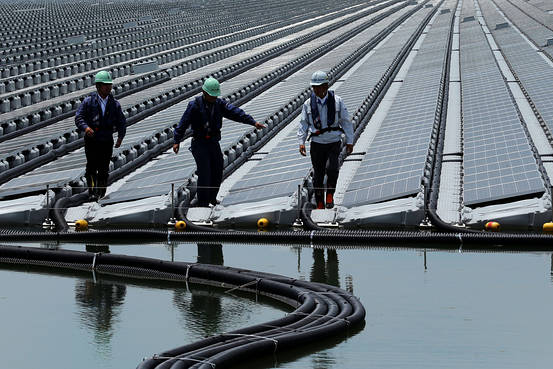- Workers walk past rows of solar panels at the 2.3-megawatt floating solar power station operated by Kyocera TCL Solar LLC.
- Bloomberg News
At a time when major electronics makers are using idled semiconductor clean rooms to grow high-quality vegetables, it should come as no surprise to see Japanese farmers floating solar panels on reservoirs that are used to water rice fields.
Thanks to a generous feed-in tariff for renewable energy, Japan has become a global force to be reckoned with in the area of floating solar power generation.
Earlier this week, the world’s largest facility by capacity started commercial operations in Hyogo prefecture, western Japan. The 2.3 megawatt Sakasamaike facility, set up on an agricultural water reservoir, was built and is operated by a joint venture between major solar cell manufacturer Kyocera Corp. and Century Tokyo Leasing Corp
Before the Sakasamaike facility came online, the world’s largest floating solar station was a 1.7MW facility also in Hyogo. And 10 months from now, Sakasamaike is likely to be knocked from the top spot by a 13.4MW facility being built on a dam reservoir in Chiba prefecture near Tokyo, according to Kyocera.
Japan has a large number of agricultural water reservoirs that keep water supplies necessary for growing rice. With land suitable for utility-scale solar generation already otherwise occupied, Kyocera is focusing on artificial ponds and lakes to build more solar facilities.
“Floating solar stations are not expensive compared with land-based solar. Equipment is more costly, but construction is simpler,” a Kyocera spokeswoman said.
Ciel Terre, a French technology firm specializing in floating solar technology, opened an office in Tokyo in 2013 and has provided equipment for floating solar ventures including Kyocera’s projects. It even started equipment production in Japan last October.
There are several firms in the floating solar field. Osaka Gas is one such company. It started operations at a 850KW floating solar station on an agricultural water reservoir in Hyogo prefecture last September. “We have received many inquiries from communities that jointly hold rights to use artificial ponds. There are a particularly large number of such ponds in Hyogo, so we’ve had many inquiries from there,” a company spokesman said.
For the latest news and analysis,

